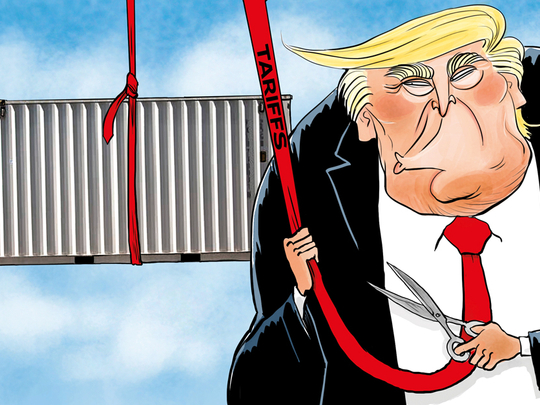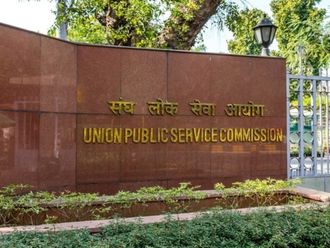
US President Donald Trump won a victory for freer trade last week when he and the president of the European Commission, Jean-Claude Juncker, agreed to find ways to lower tariffs and other barriers to each other’s exports. The outlines of the deal are still sketchy, but they call for the Europeans to buy more American petroleum, soyabeans and manufactured goods and for Trump to reduce his auto and steel tariffs.
Trump and the Europeans now have a handshake agreement to aim for zero tariffs on both sides of the Atlantic.
This was Trump’s idea. The night before the agreement, he proposed in a tweet that “Both the US and the E.U. drop all Tariffs, Barriers and Subsidies! That would finally be called Free Market and Fair Trade!” Amen.
This is a winning strategy that we’ve long endorsed with our friends at the White House because it is fully consistent with what Trump has often told us: His threat of tariffs is a negotiating tactic to get to lower trade barriers and a “level playing field.”
The next step should be to extend this zero tariff offer to other key allies, including Britain, Canada, Mexico and South Korea.
If Trump’s goal is more jobs and higher wages, America comes out the big winner under the zero tariff scenario. Most of the major US trading partners have higher tariffs than itself. A study by the president’s own Council of Economic Advisers calculates that the average American tariff is 3.5 per cent, while the average European Union rate is 5 per cent, China is nearly 10 per cent and the world average is around 10 per cent. On a level playing field, American companies can compete with anyone, and its exporters will gain advantage if trade barriers are abolished.
The alternative is higher tariffs on steel, aluminium, autos and hundreds of products imported from other countries, particularly China. Those actions have led to retaliatory tariffs imposed on products grown or manufactured in America. This has hurt farmers, the stock market and economic growth.
With this new offer to abolish tariffs, Trump might be borrowing a page from Ronald Reagan’s playbook. Throughout much of his presidency, Reagan was portrayed as an anti-Soviet hawk because he oversaw a huge expansion in American military spending.
But at a 1986 summit in Reykjavik, Iceland, Reagan proposed to the leader of the Soviet Union, Mikhail Gorbachev, the radical idea that both countries should abolish their nuclear arsenals. This caught the Soviets by surprise, and though the two leaders left Iceland with no agreement in hand, Reagan’s bold strategy ultimately laid the path to the greatest period of nuclear disarmament in history.
Seizing the moral high ground
What Trump has proposed to US trading partners is similar: the United States will abolish all its tariffs, subsidies and other trade restraints on their exports if they do the same for American exports. This solution would be the economic equivalent to total trade disarmament.
A no-tariffs trade strategy would also allow the United States to seize the moral high ground in the debate. Trump would be transformed from the evil disrupter of international commerce to a potential saviour — just as 30 years ago Reagan’s international image changed from superhawk to peacemaker almost overnight.
Finally, if Trump can secure zero tariff deals with the European Union, Canada, Mexico, Japan and South Korea, this will put America in a much stronger position as he negotiates with China. It greatly increases the odds that Trump’s hard-line stance with China will deliver long overdue concessions from Beijing that could enhance American economic and national security while averting a brutal escalation in the trade war that could hurt both our economies.
Some of our friends in the administration question whether this policy would work because in China and other countries, non-tariff barriers are the biggest deterrents to American exports. We agree that non-tariff trade restraints — such as foreign companies stealing US patents with impunity, subsidies to state-owned enterprises and currency manipulation — are a problem. But getting tariffs down creates momentum for tearing down other trade restraints.
We know lowering tariffs will be an uphill battle. Freer trade has always been an elusive pursuit because vested interests on both sides of the Atlantic, whether farmers or manufacturers, will fight to maintain tariffs that benefit their products.
We can’t predict how other nations would respond to this idea. But the European Union negotiations last week should provide Trump a clear signal that he can’t win just by swinging the stick of higher tariffs. He also needs to offer the carrots of lower barriers. By putting zero tariffs on the table, Trump will also be able to determine which nations are genuinely committed to freer trade and which prefer to keep their protectionist barriers in place.
We’ve often reminded politicians that free trade is a pillar of prosperity and a win-win for trading partners. Just as no one ever thought Reagan would stem nuclear proliferation, if Trump aggressively pursues this policy, he could build a legacy as the president who expanded world commerce and economic freedom by ending trade barriers rather than erecting them.
— New York Times News Service
Stephen Moore is a senior fellow at the Heritage Foundation. Arthur B. Laffer is chairman of Laffer Associates. Steve Forbes is chairman of Forbes Media.








